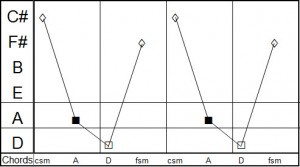Ok so now this song is stuck in my head, it got me thinking about relative minors. What would happen to this song if you swapped all the chords for their relative majors/minors. It is one of the simplest substitutions you can use so lets have a listen.
Firstly lets hear the original verse:. The chords reapeat around A-c#m-f#m-D.

SeeChord chart
Now, if we swap all of those chords for their relative majors/minors, we get this instead:

SeeChord chart of "Somebody like you" with substituted chords.
However, there are some other chords that will serve just as well for relative majors and minors. We are often told that there is only one relative major or minor, but this is not the case. Take C major for example. Music theory tells us that the relative minor is A minor. Sure enough, their chords and scale are very similar, so it is easy to see the relationship. However, there is another minor chord very similar to C major, and tha is E minor. The similarities are not so exact in the scale, but for a chord substitution it is perfectly valid.
What happens to our tune if we substitute these chords instead?:

SeeChord chart of "Somebody like you" by Adele, with relative majors/minors
Neither of the new chord progressions sound quite right as we are so used to hearing the original, and the fact that the tune fits perfectly over the original chords. However if we could pick and choose from these substitutions…

SeeChord Chart
In my opinion this sounds just as solid as the original sequence, even though none of the original chords appear in the same position. This shows the power of relative majors and minors and of substitutions. Many songs and songwriters use substituted chords to chage up their progressions. Give it a go, you might find that it creates that moment of magic you were looking for!
Ok so this is one of THE songs of the moment. Worth taking a minute to have a look at how the chords fit together. The chords for the verse and chorus are very similar:
Verse – A-c#m-f#m-D.
Chorus-A- E- f#m-D
Here is the sequence on a SeeChord chart of the verse:

SeeChord chart
This is a lovely example of how to use relative minors effectively. In my mind there are two ways of looking at this. This first, and perhaps most conventional would be to say that the relative minor of A is f#m. That would mean that the c#m chord is a way of using the strongest of all chord sequences, the falling fifth to get to the f#m chord. The D chord then provides the IV-I (or plagal) cadence that is a feature of so many rock and pop songs.
However, there is another, slightly more intruiging way of seeing this sequence. There is another minor chord that is closely related to A. In fact all major chords have two relative minors. In this case, the oter relative minor has been used, which is the c#minor chord. It is easy to see how closely related A major and c#minor are by looking at the notes in each chord:
A Major: A C# E
c#minor:G# C# E (inversion)
So we could just as validly say that the jump from A major to c#minor is a relative minor jump. This then leads nicely to the f#minor by a descending fifth. Then the leap from f#m to D is another of these alternative relative minor jumps.
Here is the Seechord chart for the chorus:

Here the c#minor chord has been replaced by the E major. A far more conservative choice, and the first time the V (5) chord has been heard. This Dominant chord provides more of a sense of security, not only because it is a major chord, but also because it helps to establish the tonic, A major. This reflects the lyrics, “Never mind I’ll find somebody like you” – bittersweet but optimistic.




